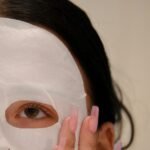The foundation of any successful makeup application lies in the preparation of the skin. Prepping your skin is not merely a step; it is an essential ritual that can significantly influence the overall appearance and longevity of your makeup. Begin by cleansing your face with a gentle cleanser suited to your skin type.
This step removes impurities, excess oil, and any remnants of previous products, creating a clean canvas for your makeup. Following cleansing, it’s crucial to exfoliate regularly, as this helps to slough off dead skin cells that can lead to a dull complexion and uneven makeup application. A mild exfoliant, whether chemical or physical, can enhance skin texture and promote a smoother finish.
After cleansing and exfoliating, hydration becomes paramount. Applying a suitable moisturizer helps to lock in moisture and create a barrier that prevents makeup from settling into fine lines or dry patches. For those with oily skin, a lightweight, oil-free moisturizer can provide hydration without adding excess shine.
Conversely, individuals with dry skin may benefit from a richer cream that nourishes and plumps the skin. Additionally, incorporating serums that target specific concerns—such as hyaluronic acid for hydration or vitamin C for brightness—can further enhance the skin’s appearance. The goal is to achieve a balanced, hydrated base that allows makeup to glide on effortlessly.
Applying Primer
Once your skin is prepped and hydrated, the next step is applying primer. Primer acts as a crucial intermediary between your skincare routine and makeup application, serving multiple purposes that enhance the overall look and longevity of your makeup. A good primer can smooth out the skin’s surface, minimize the appearance of pores, and create an even canvas for foundation application.
Depending on your skin type and desired finish, you can choose from various formulations—silicone-based primers offer a velvety texture ideal for blurring imperfections, while hydrating primers are perfect for dry skin types seeking a dewy finish. When applying primer, use your fingertips or a makeup sponge to distribute the product evenly across your face. Focus on areas that tend to be problematic, such as the T-zone for oily skin or areas with visible pores.
Allow the primer to set for a few minutes before moving on to foundation application; this waiting period ensures that the primer adheres properly to the skin and provides the best possible base for your makeup. The right primer not only enhances the application of foundation but also helps in prolonging its wear throughout the day, making it an indispensable step in any makeup routine.
Choosing the Right Foundation
Selecting the right foundation is one of the most critical decisions in your makeup routine, as it sets the tone for your entire look. With an array of options available—liquid, cream, powder, and stick foundations—understanding your skin type and desired finish is essential. For those with oily skin, matte foundations can help control shine and provide a long-lasting finish.
Conversely, individuals with dry skin may prefer hydrating formulas that impart a luminous glow. It’s also important to consider coverage; full-coverage foundations are ideal for those looking to conceal blemishes or uneven skin tone, while sheer or medium-coverage options allow for a more natural look. When testing foundation shades, it’s best to swatch several options along your jawline in natural light to find the perfect match.
The right shade should seamlessly blend into your skin without leaving a noticeable line. Additionally, consider undertones—cool, warm, or neutral—as they play a significant role in achieving a natural appearance. Once you’ve selected your foundation, apply it using a brush, sponge, or fingers depending on your preference for coverage and finish.
A damp makeup sponge can provide a flawless airbrushed effect, while a brush may offer more coverage for those needing it.
Concealing and Correcting
After establishing a solid foundation base, the next step is concealing and correcting any imperfections that may still be visible. Concealers are typically thicker than foundations and are designed to cover specific areas such as dark circles under the eyes, blemishes, or redness around the nose. When choosing a concealer, opt for one that is one or two shades lighter than your foundation for under-eye areas to brighten and lift the face.
For blemishes or discoloration, select a shade that closely matches your foundation to ensure seamless blending. Application techniques vary based on the area being concealed. For under-eye circles, use a small brush or your fingertip to gently tap the concealer into place, ensuring not to disturb the foundation underneath.
A light hand is crucial here; too much product can settle into fine lines and create an unwanted cakey appearance. For blemishes or spots, use a small brush or a clean fingertip to apply concealer directly onto the imperfection and blend outwards gently. Additionally, color correcting can be beneficial for specific concerns; for instance, peach or orange tones can neutralize blue-toned dark circles, while green concealers can counteract redness.
Setting Your Base
Setting your base is an essential step in ensuring that your makeup remains intact throughout the day. After applying foundation and concealer, using a setting powder can help absorb excess oil and prevent creasing in areas prone to movement. Translucent powders are particularly popular as they provide a matte finish without altering the color of your foundation.
When applying setting powder, use a fluffy brush to lightly dust it over areas where you applied concealer and foundation; this will help lock everything in place while maintaining a natural look. For those with dry skin who may find powder too drying, consider using a setting spray instead. Setting sprays can provide hydration while ensuring that makeup stays put for hours on end.
To apply setting spray effectively, hold it at arm’s length and mist it over your face in an “X” and “T” motion to cover all areas evenly. This step not only helps in setting makeup but also gives an added layer of freshness to your look.
Enhancing Your Eyes
The eyes are often considered the focal point of any makeup look, making their enhancement crucial in achieving an overall polished appearance. Start by applying an eyeshadow primer to ensure that your eyeshadow adheres well and lasts throughout the day without creasing. Once primed, you can begin layering eyeshadows according to your desired look—whether it’s a subtle daytime appearance or a bold evening statement.
Neutral shades work well for everyday wear, while vibrant colors can add drama for special occasions. When applying eyeshadow, use a variety of brushes to achieve different effects; fluffy brushes are excellent for blending colors seamlessly, while smaller brushes allow for precision in applying darker shades along the lash line or in the crease. Don’t forget about eyeliner; whether you prefer pencil, gel, or liquid liner depends on your comfort level and desired effect.
A tight line along the upper lash line can enhance the eyes without looking overly dramatic, while winged eyeliner can add flair for evening looks. Finish off with mascara to define and lengthen lashes; curling them beforehand can further open up the eyes.
Perfecting Your Brows
Well-groomed brows frame the face and can dramatically alter one’s appearance. The first step in perfecting your brows is determining their shape; this often involves assessing their natural arch and filling in any sparse areas accordingly. Brow pencils or powders are excellent tools for achieving this look; choose a shade that closely matches your natural brow color for a seamless finish.
When filling in brows, use short strokes to mimic natural hair growth patterns and avoid creating harsh lines. Once you’ve achieved your desired shape and fullness, setting your brows with a clear or tinted brow gel can help maintain their position throughout the day. Brow gel adds definition while keeping hairs in place without feeling stiff or crunchy.
For those looking for more permanent solutions, microblading has gained popularity as a semi-permanent technique that creates natural-looking hair strokes for fuller brows.
Adding Color to Your Cheeks
Adding color to your cheeks is essential for bringing life back into your complexion after applying foundation and concealer. Blush comes in various formulations—powder, cream, gel—and each offers different finishes ranging from matte to luminous. When selecting blush shades, consider your skin tone; peachy tones often complement warm undertones while pinks suit cooler complexions best.
For those with deeper skin tones, berry shades can provide a stunning pop of color. Application techniques vary based on blush formulation; powder blushes are best applied with an angled brush that allows for precise placement on the apples of the cheeks while blending upwards towards the temples. Cream blushes can be applied with fingers or a damp sponge for a more natural finish that melds seamlessly into the skin.
Regardless of formulation, start with a light hand and build up color gradually until you achieve your desired intensity.
Creating the Perfect Pout
The lips are often one of the most expressive features of the face; thus, creating the perfect pout is vital in completing any makeup look. Start by exfoliating your lips gently with a lip scrub or by using a soft toothbrush to remove any dry skin. Following exfoliation, apply a hydrating lip balm to prep your lips for color application; this ensures that lipstick glides on smoothly without clinging to dry patches.
When choosing lip color, consider both shade and finish—matte lipsticks offer long-lasting wear but may feel drying over time, while glossy finishes provide hydration but may require more frequent touch-ups throughout the day. Lip liners are also essential tools; they help define the lips’ shape and prevent feathering of lipstick outside the lip line. When applying lipstick or gloss, start from the center of the lips and work outward for even coverage.
Setting Your Makeup
Setting your makeup is crucial for ensuring longevity throughout the day or night ahead. After completing all aspects of your makeup application—from foundation to lips—consider using a setting spray designed specifically for this purpose. Setting sprays come in various formulations tailored to different skin types; some offer mattifying properties while others provide hydration or luminosity.
To apply setting spray effectively, hold it at arm’s length from your face and mist it evenly across all areas of your makeup look in an “X” pattern followed by a “T” pattern to ensure complete coverage. Allow it to dry naturally without touching your face; this will help lock everything in place while providing an additional layer of freshness.
Finishing Touches
The final touches of any makeup routine can elevate your look from ordinary to extraordinary. Consider adding highlighter to accentuate high points on your face such as cheekbones, brow bones, and down the bridge of your nose; this creates dimension and adds radiance to your overall appearance. Highlighters come in various forms—powder, cream, liquid—and each offers unique finishes ranging from subtle sheen to intense glow.
Additionally, don’t overlook details such as setting your brows with gel or adding false lashes for extra drama if desired. A spritz of fragrance can also serve as an excellent finishing touch that leaves you feeling confident and polished as you step out into the world. Remember that makeup is an art form; feel free to experiment with different techniques and products until you find what works best for you!
FAQs
What is the importance of perfect makeup application?
Perfect makeup application can enhance your features, boost your confidence, and create a polished look for any occasion. It can also help to create a professional appearance in the workplace.
What are the essential steps for perfect makeup application?
The essential steps for perfect makeup application include cleansing and moisturizing the skin, applying primer, foundation, concealer, setting powder, eyeshadow, eyeliner, mascara, blush, and lipstick.
How can I choose the right makeup products for my skin type?
It’s important to choose makeup products that are suitable for your skin type. For example, if you have oily skin, look for oil-free and mattifying products. If you have dry skin, opt for hydrating and creamy formulas.
What are some common mistakes to avoid during makeup application?
Common mistakes to avoid during makeup application include using the wrong shade of foundation, over-applying products, not blending properly, and neglecting to clean makeup brushes regularly.
How can I ensure my makeup lasts all day?
To ensure your makeup lasts all day, use a long-lasting primer, set your makeup with setting spray, and touch up throughout the day as needed. It’s also important to choose makeup products with long-wearing formulas.









